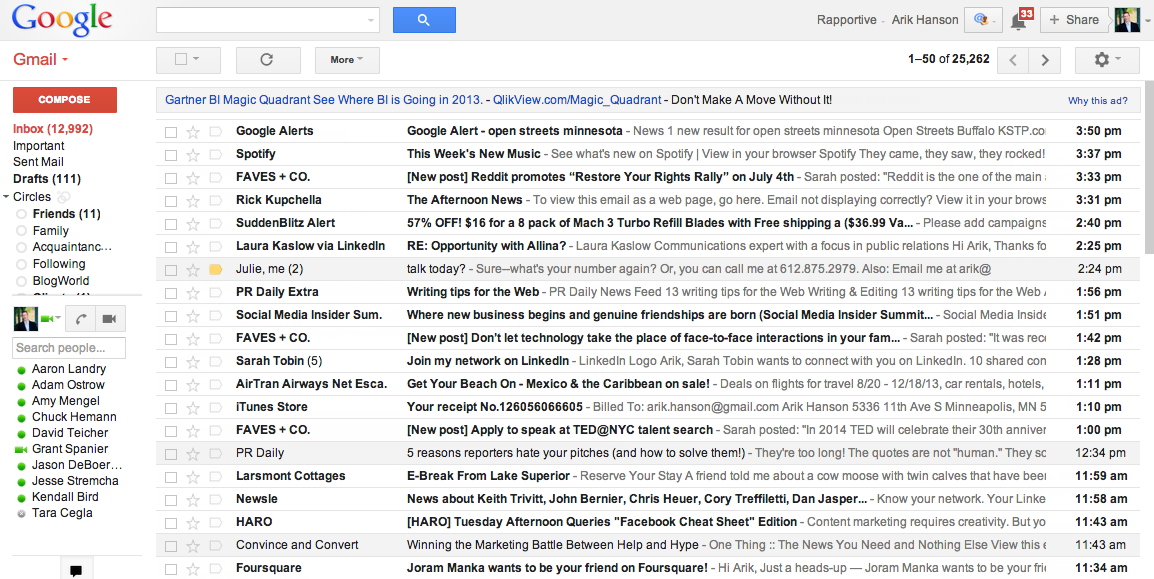 |
| Mailbox: Starting with the end in mind. |
Today I'm expounding on the Mailbox App, one of the staples in my ever-expanding search for the most efficient products to save time. I'll describe a few of the key value propositions of the product, but I don't want this post to be exclusively a feature review - there are many, many, many examples of that already. Instead, I'd like to focus on the steps that got Mailbox to launching the beautiful product it has now, and what Mailbox did well in product management along the way.
Addressing The Problem
When I worked at RPM Ventures, I was assigned to help portfolio company Eden Park Illumination, a high-tech plasma lighting startup, with a product launch in the film industry. At the recommendation of Eden Park's Chief Marketing Officer, I met with film studio managers and lighting technicians to find what customer pains they saw in the film lighting industry, and how Eden Park's product delivered value to them.
Knowing your customer's problem is always vital, and Mailbox's motto, "Put email in its place", strikes at the quintessential problem of inboxes today - too much clutter.
 |
| Do I mark it as unread? High importance? Flag or star it? Add a tag? |
Executing The Pivot
For those who remember, the team behind Mailbox wasn't originally working on email simplification. Back in 2011, their original product, Orchestra, gave users a collaborative To-Do list that could attach conversations to specific items. By 2012, they paused development on Orchestra, after finding email as the larger consumer pain. Last month, they shut down Orchestra altogether, freeing up developers to focus on Mailbox. TechCrunch describes their shift like this:
In fact, the company was a case study in what a well-executed pivot should look like – it realized early on that the product wasn’t breaking out to become a mainstream hit, so the team took their initial learnings and applied them to a new area. Orchestra [...] inspired the team to treat emails basically like to-do’s when they moved on to building what then became Mailbox.The idea of turning email into a To-Do list was brilliant for Mailbox, but was only possible from observing their Orchestra users and pivoting to a greater need.
Surviving The Acquisition
 |
| For an out-of-the-box application, Mailbox fit Dropbox pretty well. |
Sometimes, when a startup is acquired by a larger company, product development slows to a crawl while internal reorganization takes precedence. For a consumer-focused digital startup, this can be deadly.
As an example, over the summer I was introduced to Giftly, an app startup that sends digital location-based giftcards to your friends and family far-away. I liked their product pitch enough to buy a Giftly for my dad to a restaurant near him for his birthday. Shortly afterwards, Giftly was acquired by Giftcards.com, and hasn't quite recovered. Their app hasn't been updated since April, despite several 1-star reviews complaining about basic functionality glitches. Their online presence has been negligible, with only a single original Tweet and zero blog posts since the acquisition.
Luckily for Mailbox, their acquisition by Dropbox didn't slow their product development at all, and they even launched an iPad application just two months later. Soon, Dropbox offered 1GB of additional space to Mailbox users who would link their account to Dropbox, providing a legitimate reason to download Dropbox on a mobile device - I had never thought about connecting my Dropbox to my phone until I could attach documents from Dropbox directly to emails in Mailbox. The acquisition provided a tide which lifted both boats, making it trendy and feasible to complete all your email tasks from your smartphone.
Launching The Vision
Phew! KPCB readers, are you still with me? Good, because we're getting to the heart of why Mailbox is my favorite digital product: The Launch.
Over the past summer, I got to work alongside Kurt Skifstad, the VC entrepreneur-in-residence who founded Kontextual, a data-analytics platform for enterprise resource planning. Kontextual was in the process of launching an upgraded platform to its users, beginning with a few well-known users who could find major bugs without risk of leaving the platform, termed "friendlies" (I was one of these friendlies, shown here testing the beta before the product release). In Kontextual's rolling release, I discovered the importance of finding the right speed to release a product into the market - too slow and you lose the patience of the user base, too fast and you risk being burned by unforeseen glitches.
Mailbox's product launch was beautiful. Despite being relatively new, they had gathered a significant amount of hype before the release of this application, including 1.2 million views of their demo video, and 250,000 pre-launch signups. Their product had the personal support of MG Siegler, General Partner at Google Ventures, and he supported them with teasing blog posts.
Rather than releasing the product to everyone at once, Mailbox delivered the product in a first-come-first-serve manner, giving priority to those who had followed the app for a long time (friendlies) and giving themselves time to fix major bugs before rolling out to early adopters, the early majority, and eventually the mass market. To appease users who were waiting, the app showed a screen marking your place in line:
 |
| Can you imagine all of San Francisco waiting behind you? |
Not only did this give users an idea of when they would receive the product, it reinforced the idea that Mailbox was the "next big thing" by showing a growing number of people "in line" behind you. When users (such as myself) finally received the product, it worked cleanly and exactly as advertised.
It takes a lot of mess and stress behind the scenes to launch effectively - but, as Mailbox proves, nothing is as beautiful as a simple, functional product.
---
Matthew Nicholas, Eclectic Entrepreneur, can be reached at mattnich@umich.edu, or on Twitter @MattAtMich.